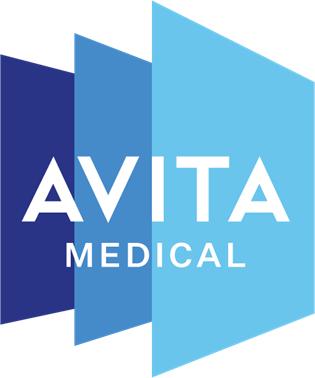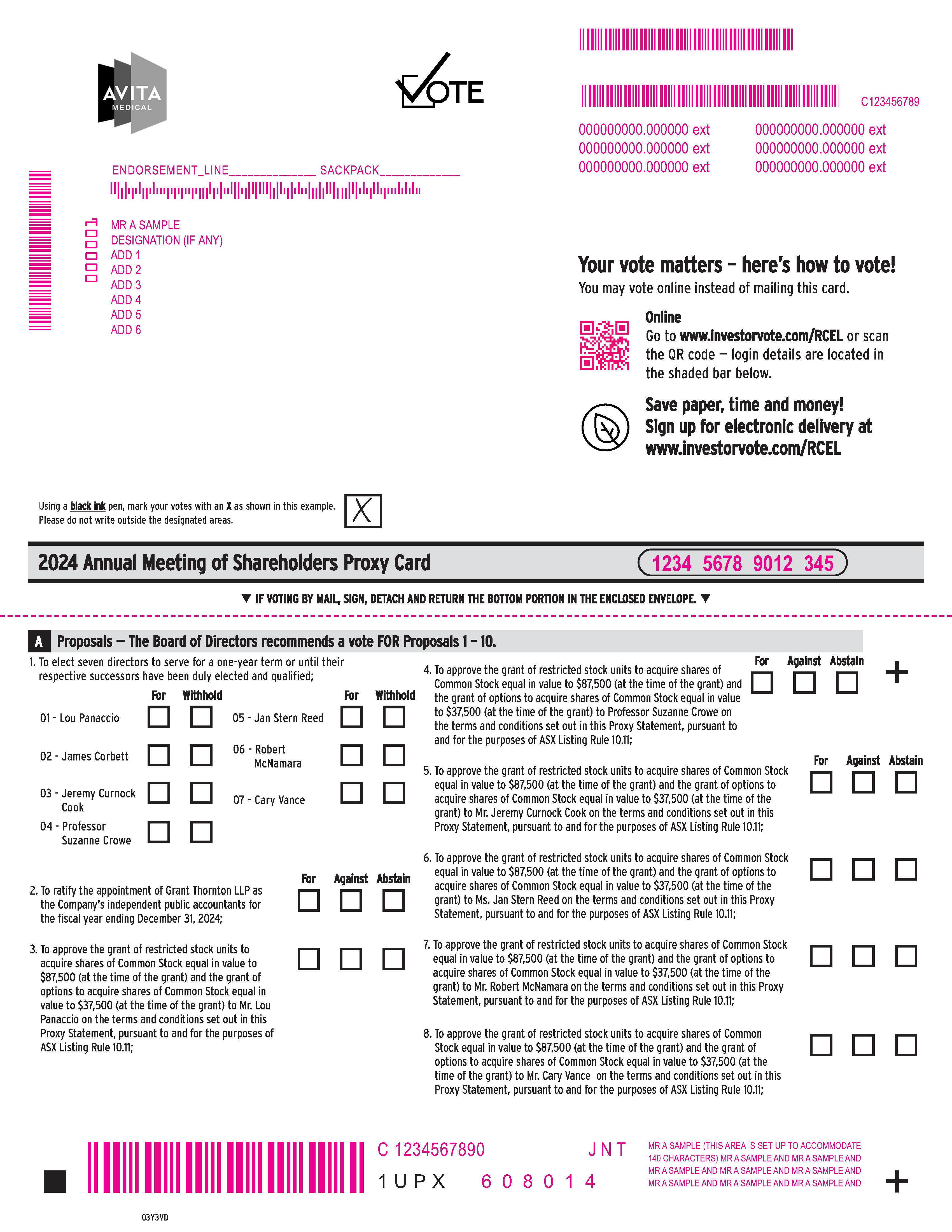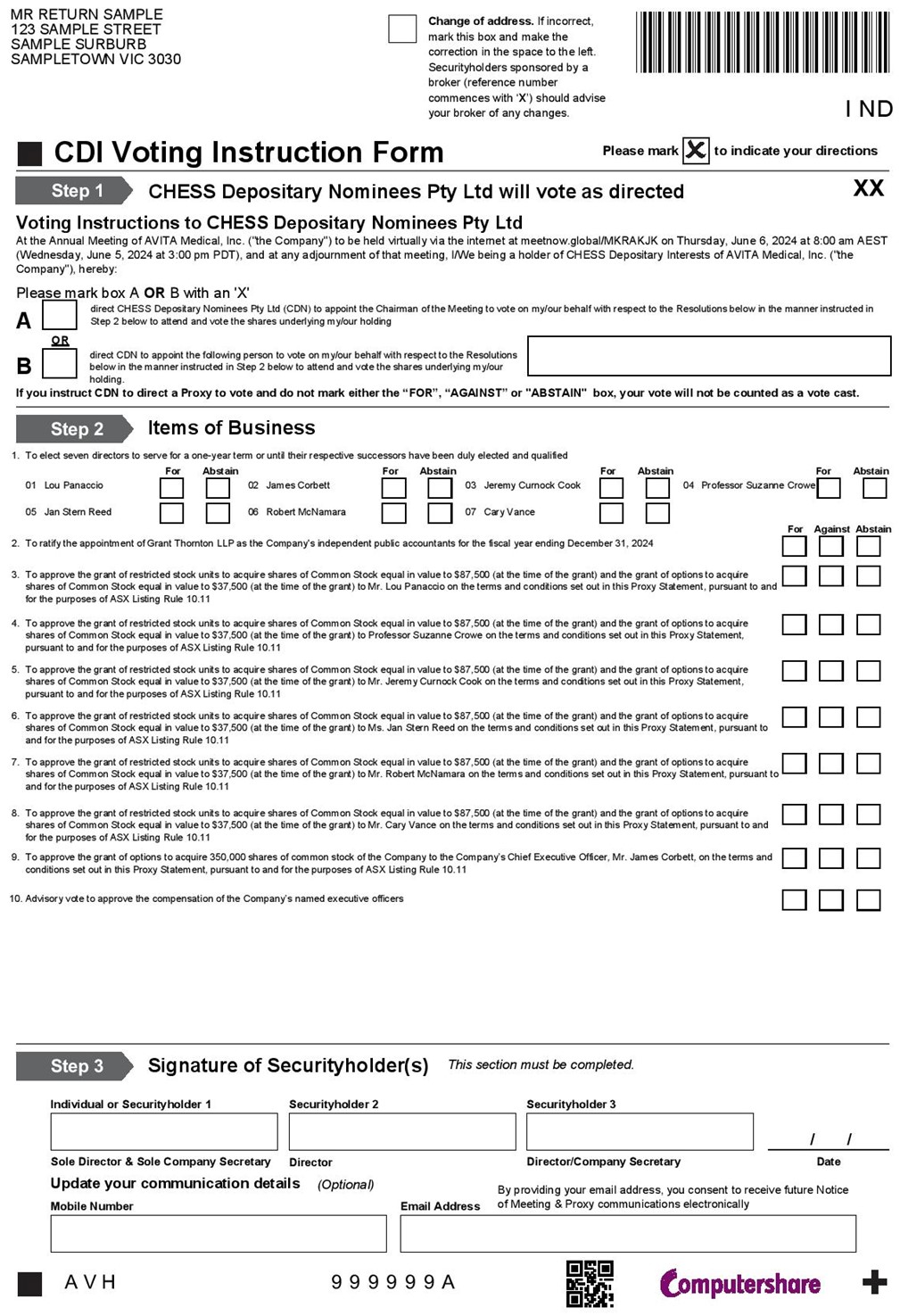

AVITA MEDICAL, INC.
28159 Avenue Stanford, Suite 220
Valencia, CA 91355
PROXY STATEMENT
for
ANNUAL MEETING OF STOCKHOLDERS
to be held on June 6, 2023,5, 2024, at 3:00 p.m. (PacificPacific Daylight Time)Time
(being June 7 2023,6, 2024, at 8:00 a.m. (AustralianAustralian Eastern Standard Time (“AEST”))Time)
SOLICITATION OF PROXY
The accompanying proxy is solicited on behalf of the board of directors (the “Board of Directors” or “Board”) of AVITA Medical, Inc., a Delaware corporation (“AVITA” or the “Company”),Company, for use at the annual meeting of stockholders of the Company (the “Annual Meeting”) to be held on June 6, 2023,5, 2024, at 3:00 p.m. Pacific Daylight Time (being June 7, 2023,6, 2024, at 8:00 a.m. Australian Eastern Standard Time)Time ("AEST")) by way of a virtual meeting conducted via live webcast with an online voting platform at meetnow.global/MD7TYY7.MKRAKJK. This Proxy Statement contains information about the matters to be considered at the meeting or any adjournments or postponements of the meeting. In addition to mail, proxies may be solicited in person or by telephone, facsimile and email by the Company’s directors, officers and regular employees, without additional compensation. The Company will bear the cost of solicitation of proxies. In addition to solicitation by mail, the Company's directors, officers, and regular employees may solicit proxies in person, by telephone, or via other means of communication without additional compensation. Brokerage houses, banks and other custodians, nominees, and fiduciaries will be reimbursed for out-of-pocket and reasonable expenses incurred in forwarding proxies and proxy statements.
The Board of Directors has set 5:00 p.m. Pacific Daylight Time on April 13, 202311, 2024 (being 10:00 a.m. AEST on April 14, 2023)12, 2024) as the record date (the “Record Date”) to determine those holders of record of shares of common stock ("Common StockStock") who are entitled to notice of, and to electronically vote at, the Annual Meeting and those holders of CHESS Depositary Interests (“CDIs”) (representing the underlying shares of Common Stock) who are entitled to notice of, and to virtually attend (but not vote at), the Annual Meeting. Each share of Common Stock (including the underlying shares of Common Stock represented by CDIs, with five CDIs representing one share of Common Stock) entitles its owner to one vote. On the Record Date, there were xx,xxx,xxxXX,XXX,XXX shares of Common Stock outstanding (including the shares of Common Stock underlying CDIs).
On or about April 18, 2023, this Proxy Statement, the23, 2024, we will begin disseminating notices of proxy card (the “Proxy Card” or “Proxy”) and the CDI Voting Instruction Form (as applicable) are being mailedmaterial availability to our stockholders and CDI holders of record as of the Record Date.Date, directing stockholders to a website where they can access our proxy materials, including this proxy statement and our 2023 Annual Report, and view instructions on how to vote online.
IMPORTANT: To ensure that your shares of Common Stock are represented at the Annual Meeting, please vote your shares of Common Stock (or, for CDI holders, direct CHESS Depositary Nominees Pty Ltd (“CDN”) to vote your CDIs) via marking, signing, dating, and returning the enclosed Proxy Card or CDI Voting Instruction Form (as applicable) to the address specified. If you attendHolders of Common Stock, as of the Record Date, may vote during the virtual Annual Meeting you may vote via the online platform at meetnow.global/MD7TYY7 if you qualify to do so,MKRAKJK, even if you have previously voted your shares of Common Stock, except thatStock. CDI holders may only instruct CDN to vote on their behalf by completing and signing the CDI Voting Instruction Form and mayare not eligible to electronically vote during the virtual Annual Meeting.
GENERAL INFORMATION AND VOTING INSTRUCTIONS
ABOUT THE MEETING
How will I receive these proxy materials?
We are furnishing proxy materials to our stockholders via the internet instead of mailing printed copies, unless otherwise requested by the stockholder. This process allows us to expedite communication to our stockholders, reduces the environmental footprint of our Annual Meeting as well as the costs associated with printing and mailing these materials to all stockholders.
Accordingly, on or about April 23, 2024, we will begin mailing notices of proxy material availability to our stockholders of record at the close of business on the Record Date. All record and beneficial stockholders will have the ability to access the proxy materials on the website referred to in the notices free of charge or request to receive a printed set of the proxy materials for the Annual Meeting. Instructions on how to access the proxy materials over the internet or to request a printed copy may be found in the notices.
Brokers, banks and other nominees will be sending a similar notification to all beneficial owners of stock who hold their shares through such broker, bank or nominee.
What is being considered at the meeting?
You will be voting on the following:
•
Proposal No. 1: To elect seven directors to serve for one-year terms or until their respective successors have been duly elected and qualified;
•
Proposal No. 2: The ratification ofTo ratify the appointment of Grant Thornton LLP as the Company’s independent public accountants for the fiscal year ending December 31, 2023;2024;
•
Proposal 3:No. 3: To approve the grant of restricted stock units to acquire shares of Common Stock (which may be represented by CDIs) equal in value to $87,500 (at the time of the grant) and the grant of options to acquire shares of Common Stock (which may be represented by CDIs) equal in value to $37,500 (at the time of the grant) to Mr. LouLouis Panaccio on the terms and conditions set out in this Proxy Statement, pursuant to and for the purposes of ASX Listing Rule 10.11;
•
Proposal 4: No. 4: To approve the grant of restricted stock units to acquire shares of Common Stock (which may be represented by CDIs) equal in value to $87,500 (at the time of the grant) and the grant of options to acquire shares of Common Stock (which may be represented by CDIs) equal in value to $37,500 (at the time of the grant) to Professor Suzanne Crowe on the terms and conditions set out in this Proxy Statement, pursuant to and for the purposes of ASX Listing Rule 10.11;
•
Proposal No. 5: To approve the grant of restricted stock units to acquire shares of Common Stock (which may be represented by CDIs) equal in value to $87,500 (at the time of the grant) and the grant of options to acquire shares of Common Stock (which may be represented by CDIs) equal in value to $37,500 (at the time of the grant) to Mr. Jeremy Curnock Cook on the terms and conditions set out in this Proxy Statement, pursuant to and for the purposes of ASX Listing Rule 10.11;
•
Proposal 6:No. 6: To approve the grant of restricted stock units to acquire shares of Common Stock (which may be represented by CDIs) equal in value to $87,500 (at the time of the grant) and the grant of options to acquire shares of Common Stock (which may be represented by CDIs) equal in value to $37,500 (at the time of the grant) to Ms. Jan Stern Reed on the terms and conditions set out in this Proxy Statement, pursuant to and for the purposes of ASX Listing Rule 10.11;
•
Proposal No. 7: To approve the grant of restricted stock units to acquire shares of Common Stock (which may be represented by CDIs) equal in value to $147,000 (at the time of the grant) and the grant of options to acquire shares of Common Stock (which may be represented by CDIs) equal in value to $63,000 (at the time of the grant) to Mr. Robert McNamara on the terms and conditions set out in this Proxy Statement, pursuant to and for the purposes of ASX Listing Rule 10.11, in recognition of Mr. McNamara being appointed as a new director of the Company during 2023;
Proposal 8: To approve the grant of restricted stock units to acquire shares of Common Stock (which may be represented by CDIs) equal in value to $87,500 (at the time of the grant) and the grant of options to acquire shares of Common Stock (which may be represented by CDIs) equal in value to $37,500 (at the time of the grant) to Mr. Robert McNamara on the terms and conditions set out in this Proxy Statement, pursuant to and for the purposes of ASX Listing Rule 10.11;
•
Proposal 9No. 8: To approve the grant of restricted stock units to acquire shares of Common Stock (which may be represented by CDIs) equal in value to $147,000$87,500 (at the time of the grant) and the grant of options to acquire shares of Common Stock (which may be represented by CDIs) equal in value to $63,000$37,500 (at the time of the grant) to Mr. Cary Vance on the terms and conditions set out in this Proxy Statement, pursuant to and for the purposes of ASX Listing Rule 10.11, in recognition of Mr. Vance being appointed as a new director of the Company during 2023;10.11;
•Proposal 10: To approve the grant of restricted stock units to acquire shares of Common Stock (which may be represented by CDIs) equal in value to $87,500 (at the time of the grant) and the grant of
| options to acquire shares of Common Stock (which may be represented by CDIs) equal in value to $37,500 (at the time of the grant) to Mr. Cary Vance on the terms and conditions set out in this Proxy Statement, pursuant to and for the purposes of ASX Listing Rule 10.11;
|
Proposal 11No. 9: To approve the grant of options to acquire 100,000350,000 shares of common stock of the Company (which may be represented by CDIs)Common Stock to the Company’s Chief Executive Officer, Mr. James Corbett, on the terms and conditions set out in this Proxy Statement, pursuant to and for the purposes of ASX Listing Rule 10.11;
and
•
Proposal 12: To approve (a) an amendment to the 2020 Omnibus Incentive Plan (the “Plan”), the terms of which are summarized in this Proxy Statement (the “Plan Amendment”); and (b) for purposes of ASX Listing Rule 7.2 Exception 13(b) and for all other purposes, the issue of equity securities in the Company under and subject to the terms of the Plan for three years commencing on the date that this proposal is approved by the Company’s stockholders as an exception to ASX Listing Rule 7.1;
Proposal 13: To approve (a) the adoption of the Company’s Employee Stock Purchase Plan (the “ESPP”), the terms of which are summarized in this Proxy Statement; and (b) for the purposes of ASX Listing Rule 7.2 Exception 13(b) and for all other purposes, the issue of equity securities in the Company under and subject to the terms of the ESPP within three years from the date that this proposal is approved by the Company’s stockholders as an exception to ASX Listing Rule 7.1; and
Proposal 14No. 10: Advisory vote to approve the compensation of the Company’s named executive officers.
Who is entitled to vote at the meeting?vote?
You may vote if you owned Common Stock or CDIs on the Record Date.Date of April 11, 2024 at 5:00 p.m. Pacific Daylight Time (being 10:00 a.m. AEST on April 12, 2024). Each share of Common Stock is entitled to one vote. Each CDI holder is entitled to direct CDN to vote one vote for every five CDIs held by such holder on the Record Date.
What does it mean to be a stockholder of record?
If, on the Record Date, your shares of Common Stock were registered directly in your name with the Company’s transfer agent, Computershare, then you are a “stockholderstockholder of record.” As a stockholder of record, you are entitled to vote on all matters to be voted on at the Annual Meeting. Whether or not you plan to attend the annual meetingAnnual Meeting online, the Company urges you to vote by the internet at meetnow.global/MD7TYY7, by telephone, or (if you are reviewing a paper copy of this proxy statement) to fill out and return the proxy card that was included with the proxy statement, to ensure your vote is counted.
What does it mean to beneficially own shares in “street name?”
If, on the Record Date, your shares of Common Stock were held in an account at a broker, bank, or other financial institution (the Company will refer(collectively referred to those organizations collectively as a “broker”), then you are the beneficial owner of shares held in “streetstreet name,” and these proxy materials are being forwarded to you by your broker. The broker holding your account is considered the stockholder of record for purposes of voting at the Annual Meeting. As the beneficial owner, you have the right to direct your broker on how to vote the shares in your account. The information you receive from the broker will include instructions on how to vote your shares. In addition, you may request paper copies of the Proxy Statement and voting instructions by following the instructions on the notice provided by your broker.
Your broker is not permitted to vote on your behalf on any matter to be considered at the Annual Meeting (other than ratifying the Company’s appointment of Grant Thornton LLP as the Company’s independent registered public accounting firm) unless youyour broker votes specifically vote in accordance with the instructions provided by you to your broker. The Company encourages you to communicate your voting decisions to your broker before the deadlines described elsewhere in this proxy statementProxy Statement to ensure that your vote will be counted.
What does it mean to be a holder of CDIs?
CDIs are issued by the Company through CDN and traded on the Australian Securities Exchange (the “ASX”). If you own the Company’s CDIs, then you are the beneficial owner of one share of Common Stock for every five CDIs that you own. CDN or its custodian is considered the shareholder of record for the purposes of voting at the Company’s Annual Meeting. As the beneficial owner, you have the right to direct CDN or its custodian as to how to vote the shares in your account. As a beneficial owner, you are invited to attend the Annual Meeting. However, because you are not a stockholder of record, if you personally want to vote the shares of Common Stock underlying your CDIs at the Annual Meeting, you must inform CDN via your CDI Voting Instruction Form that you wish to nominate yourself (or another person, including the Chair of the Annual Meeting) to be appointed as CDN’s proxy for the purposes of virtually attending and voting at the Annual Meeting.
Under the rules governing CDIs, CDN is not permitted to vote on your behalf on any matter to be considered at the Annual Meeting unless you specifically instruct CDN how to vote. The Company encourages you to communicate your voting decisions to CDN in advance of the Annual Meeting to ensure that your vote will be counted by completing the enclosed CDI Voting Instruction Form and returning it to the address specified on that form.
How many votesshares must be present or represented to hold the meeting?
Your shares are counted as present at the meeting if you attend the meeting virtually and vote via the online platform at meetnow.global/MD7TYY7MKRAKJK or if you properly return a Proxy (in the case of holders of Common Stock) or CDI Voting Instruction Form (in the case of holders of CDIs). To conduct the meeting, the holders of not less than a majority in voting power of the outstanding shares of stock entitled to vote must be present at the meeting in person or by proxy. This is referred to as a quorum. On the Record Date, there were xx,xxx,xxxXX,XXX,XXX outstanding shares of Common Stock (including Common Stock underlying CDIs) entitled to vote.
How do I vote if I hold shares of Common Stock?
Registered holders of Common Stock can vote in three ways:
•
by means of the internet by visiting www.investorvote.com/RCEL and following the instructions on the notice or Proxy Card;
•by attending the meeting virtually via live webcast and voting using the online voting platform at meetnow.global/MD7TYY7MKRAKJK using the your unique 16-digit Control Number, provided in the Notice of Annual Meetingwhich can be found on your notice or Proxy Card, to log in to the website; or
by submitting a proxy over the internet by following the instructions [on the website referred to in the Notice of Internet Availability of Proxy Materials on the Proxy Card by no later than x:xx p.m. (Pacific Standard Time) / x:xx p.m. (Eastern Standard Time) on ____, 2023 (being x:xx am (AEDT) on _______, 2023) ]; or
by completing, signing, and returning the enclosed Proxy Card in accordance with the instructions on such card.
If you hold shares of Common Stock in “streetstreet name,” you will need to follow the instructions provided by the broker, bank or other nominee that holds your shares.
How do I vote if I hold CDIs?
Each CDI holder as of the Record Date is entitled to direct CDN to vote one vote for every five CDIs held by such holder. Those persons holding CDIs as of the Record Date are entitled to receive notice of, and to attend the Annual Meeting virtually, and any adjournment or postponement thereof. Holders of CDIs as of the Record Date may direct CDN to vote their underlying shares of Common Stock at the Annual Meeting in two ways:
•by returning the CDI Voting Instruction Form to Computershare Australia, the agent the Company has designated for the
collection and processing of voting instructions from the Company’s CDI holders. holders; or
•by completing the CDI Voting Instruction Form online at https://www.investorvote.com.au.
Votes must be received by Computershare Australia by no later than 9:00 am (AEST)a.m. AEST on Thursday, June 1, 2023,May 31, 2024, (being 4:00 pmp.m. Pacific Daylight Time / 7:00 pm Eastern Daylight Time on Wednesday, May 31, 2023)30, 2024) in accordance with the instructions on such form, in order for CDN to vote on CDI holders’ behalf in accordance with their written directions.
Alternatively, CDI holders can inform CDN via the CDI Voting Instruction Form that they wish to nominate themselves or another person (including the Chair of the Annual Meeting) to be appointed as CDN’s proxy for the purposes of virtually attending and voting at the Annual Meeting. Holders of CDIs must comply with the instructions above if they wish to have their votes cast at the Annual Meeting.
In order to receive electronic communications from the Company in the future, please update your Shareholder details online at www.investorvote.com.au and log in with the control number: XXXXX, your unique shareholder identification number, and postcode (or country for overseas residents). Once logged in, you can also lodge your CDI Voting Instruction Form electronically.
Can I change my mind after I submit my Proxy or CDI Voting Instruction Form?
Yes, if you hold shares of Common Stock, you may change your mind at any time before a vote is taken at the meeting. You can do this by (1) signing another Proxy with a later date and submitting it in the same manner as the prior Proxy was submitted; (2) if you hold your shares in your name, voting again at the meeting via the online voting platform; or (3) if you hold your shares in street name, arranging with your broker to vote your shares at the Annual Meeting.
If you are a holder of CDIs and you direct CDN to vote by completing the CDI Voting Instruction Form, you may revoke those directions by delivering to Computershare Australia a written notice of revocation bearing a later date than the CDI Voting Instruction Form previously sent, which notice must be received by Computershare Australia by no later than 9:00 am (AEST)a.m. AEST on Thursday, June 1, 2023,May 31, 2024, (being 4:00 pmp.m. Pacific Daylight Time / 7:00 pm Eastern Daylight Time on Wednesday, May 31, 2023)30, 2024).
Will my sharesCommon Stock or CDIs be voted if I do not provide my Proxy or CDI Voting Instruction Form?
If you hold your shares of Common Stock directly in your own name, they will not be voted if you do not provide a Proxy unless you personally vote at the meeting via the online voting platform. Your shares of Common Stock may be voted under certain circumstances if they are held in the name of a brokerage firm. Brokerage firms generally have the authority to vote a customer’s unvoted shares on certain “routine”routine matters. At the Annual Meeting, the proposal to ratify the appointment of the Company’s independent public accountants is such a “routine”routine matter. When a brokerage firm votes its customer’s unvoted shares, these shares are counted for the purposes of establishing a quorum.
If you hold CDIs, they will not be voted if you do not provide a completed CDI Voting Instruction Form to Computershare Australia by the relevant cut-off date, being 9;9:00 am (AEST)a.m. AEST on Thursday, June 1, 2023May 31, 2024 (being 4:00 pmp.m. Pacific Daylight Time / 7:00 pm Eastern Daylight Time on Wednesday, May 31, 2023)30, 2024).
What if I return my Proxy Card or CDI Voting Instruction Form but do not include voting instructions?
Proxies that are signed and returned but do not include voting instructions will be voted FOR the election of the nominated directors, FOR the ratification of the appointment of the Company’s independent public accountants, FOR the approval of the grant of restricted stock units and options to each non-executive director, and FOR the approval of the grant of options to the Company’s President and Chief Executive Officer, FOR the approval of the Plan Amendment, and FOR the approval of the Employee Stock Purchase Plan, but they will not be voted with respect to the advisory vote regarding compensation paid to the Company’s named executive officers. If no specific instructions are given, it is intended that signed and returned proxies will be voted in the discretion of the proxy holders on any other business proposal which may properly come before the Annual Meeting (the Board of Directors does not presently know of any other such business) or any adjournments or postponements thereof.
If you are a beneficial owner of shares of Common Stock held in street name and do not provide the organization that holds your shares with specific voting instructions, the organization that holds your shares may generally vote on routine matters (which at the Annual Meeting consists of the proposal regarding ratification of the appointment of the Company’s independent public accountants) but cannot vote on non-routine matters.






